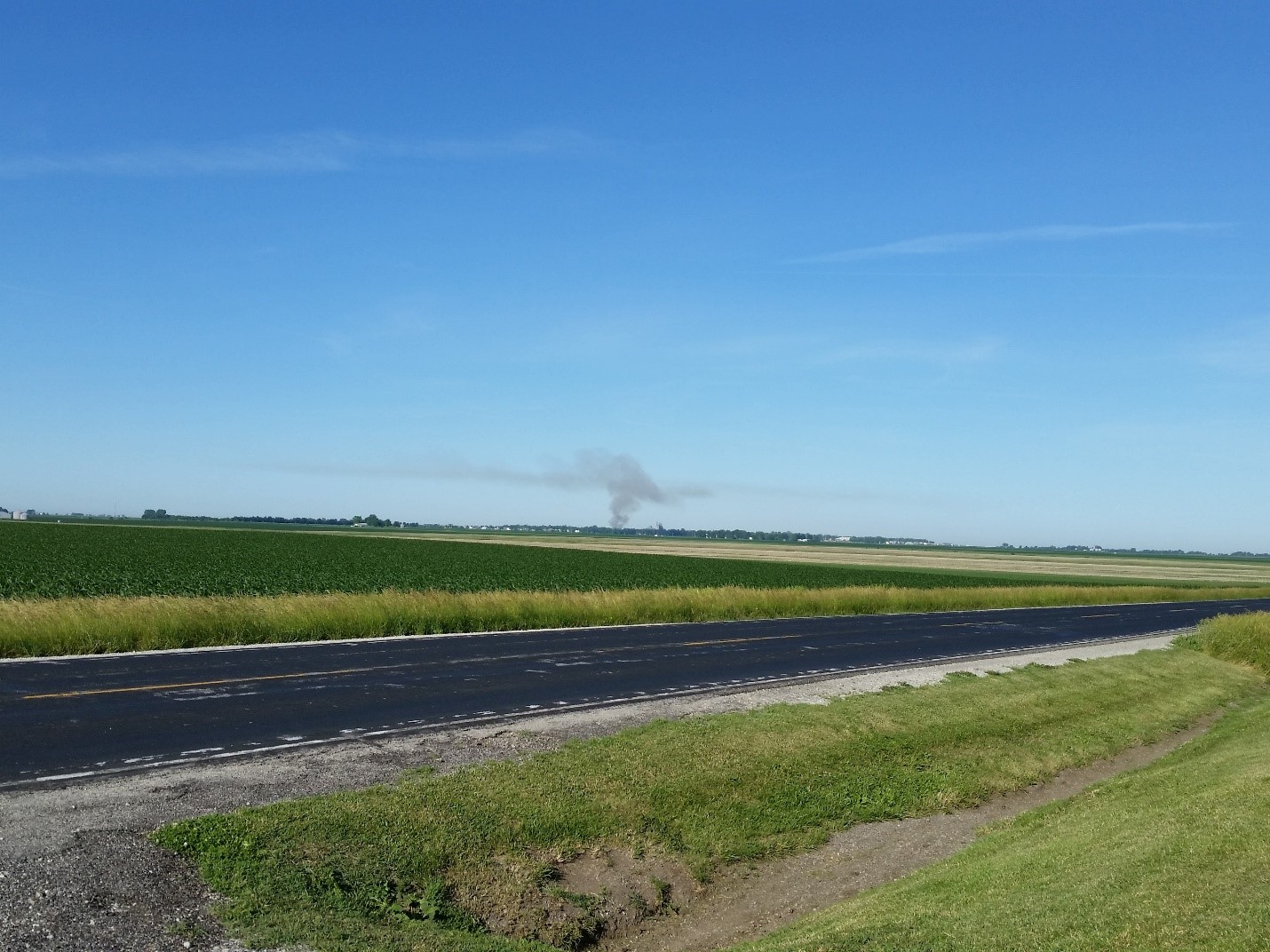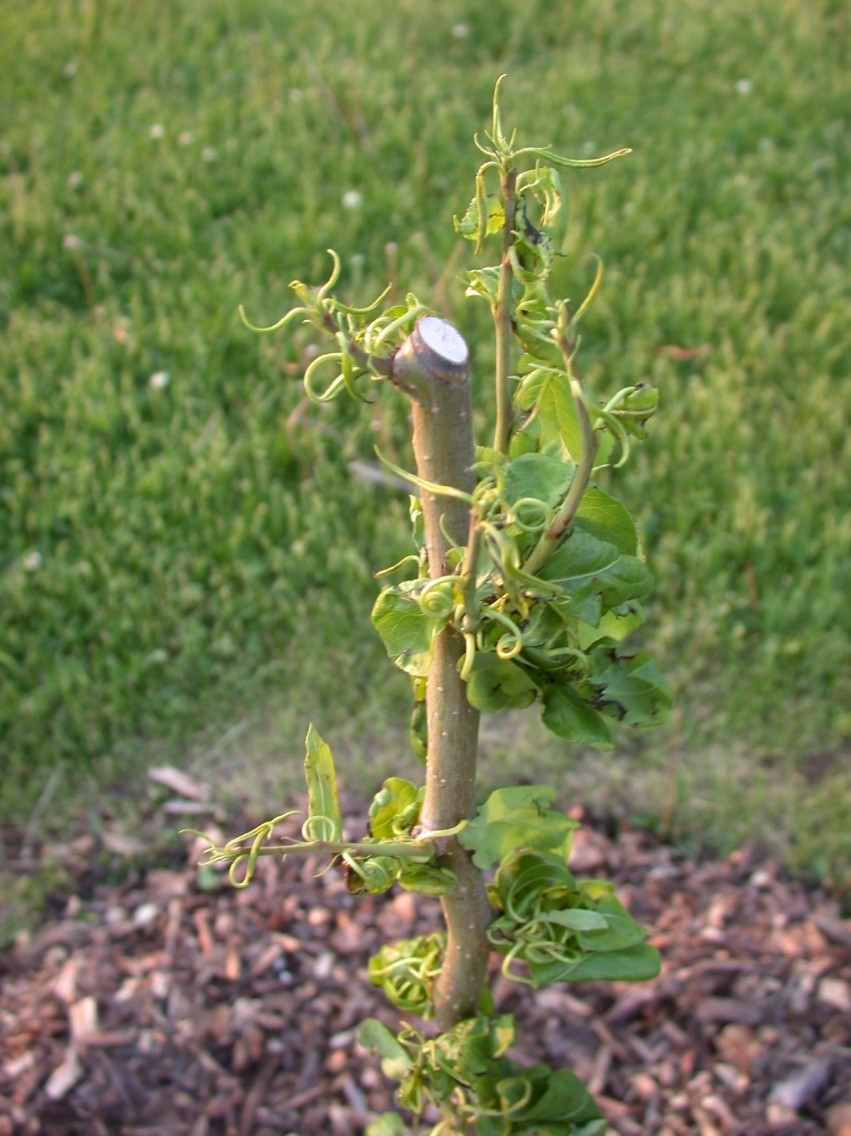Issue 5, June 17, 2021
Understanding and Preventing Off-target Movement of Herbicides
Off-target movement occurs when a pesticide moves out of the area intended for application and can cause damage to desirable vegetation, humans, and wildlife. Any pesticide can move off-target but herbicides tend to result in the most easily visible damage. In this article, we will discuss the different types off-target movement, the factors that influence each, prevention, and why this topic is more important now than ever before. When applicators are more informed and have a better understanding of these issues, they can act accordingly to better keep their applications on target.
Pesticides can move off-target by air and by water. When they move by air, we call this drift. Each year, the Illinois Department of Agriculture (IDA) receives on average approximately 120 pesticide misuse complaints, of which 60% are pesticide drift complaints. Recently, it’s been higher with the change in use patterns of dicamba and 2,4-D that are being used more frequently and much earlier (and sometimes later) in the season. There are two types of drift. Particle drift is the movement of spray droplets and it’s influenced by nozzle size (which determines droplet size), wind speed, and wind direction. Smaller droplets provide nice coverage on a leaf but weigh less and are carried easily by the wind. Larger droplets are heavier but may roll off the leaf. It’s a balancing act for applicators. Prevent particle drift by using drift reduction nozzles that produce fewer small droplets. Operate at a lower pressure and lower your spray height so droplets have a shorter distance to travel to the target site. Do not spray in winds greater than 10 MPH. Do not spray when there is no wind as this can indicate an inversion. Check downwind for sensitive areas and use untreated buffers or return to spray later when winds are blowing away from the area. Additionally, drift reduction adjuvants can help result in larger droplets but you want to ensure you have a compatible product for your product and equipment.
Inversions are where particles can hang in the air like fog and then move once the wind picks up speed. They are complicated and fortunately are being researched. Inversions are challenging for applicators to identify but smoke that flattens out can indicate the presence of one. They are more likely to occur on clear nights with little to no cloud cover. They begin in the evening, build in intensity overnight, and generally dissipate in the morning once the temperature rises 3 degrees so we recommend applicators wait until then to spray.

Smoke that flattens out can indicate the presence of an inversion. Michelle Wiesbrook, University of Illinois.
Vapor drift is the movement of spray vapors or gasses. These can be produced up to several days after application and can travel a few miles. All pesticides are susceptible but some that can volatilize to a significant degree are these herbicides: dicamba, 2,4-D, and clomazone. A very small amount can injure very sensitive plants such as ornamentals, grapes, tomatoes, and soybeans. Vapor drift is influenced by formulation and temperature. Prevent vapor drift by avoiding applications during hot weather. Many labels will direct users to not apply when temperatures are above 85 degrees. Use less volatile formulations when possible. Ester formulations are more volatile than amine formulations. If given a choice and temperatures are warm, go with the amine. Save the esters for cooler weather. Check the label for warning statements. Keep in mind that the applicator is responsible for drift even if it’s not easily seen so it’s best to use practices to prevent drift.
Pesticides can also move off a treated area with water by runoff and contaminate surface water such as ponds and streams. Erosion can cause contamination if pesticides are attached to the sediments. Many factors affect this including soil and pesticide properties, vegetative cover, volume and rate of water, topography, & climate. Prevent surface water contamination by avoiding treating bare slopes, not spraying before heavy rain, using untreated vegetation filter or buffer strips, and following surface water advisory statements on labels.
Pesticides can contaminate groundwater by run-in and leaching. Run-in occurs when pesticides move directly from the soil surface to the groundwater before they are adsorbed or degraded. Run-in can occur through abandoned wells, cracks, and sinkholes. Shallow aquifers are at greater risk because the distance to travel is short. Pesticides can also move downward through the soil with percolating water. This leaching occurs mainly in sandy, permeable soils. It’s a real problem when the water table is close to the surface with shallow wells drawing from it. Leaching is influenced by several factors including pesticide properties (including solubility, adsorption, and persistence), soil properties, site conditions, and management practices including spills, improper disposal of containers and unwanted pesticides, and back siphoning while filling tanks.
Leaching is more likely to occur with sandy soils, groundwater that is close to the surface, and with lots of water moving downward through soil. Additionally, leaching is more likely with pesticides that are highly persistent, poorly adsorbed to soil, and highly water soluble. Prevent leaching by reading and following label directions and check the label for application restrictions; many include water advisory statements. Be familiar with your site conditions and choose products wisely such as those with a lower potential to move.
Of course many problems can be alleviated simply by using other control methods and saving herbicides for when they are absolutely necessary. Scouting should always be used first to determine if there is a need to use chemicals. Use the lowest labeled rate and application frequency to achieve acceptable control. However, if you are dealing with possible herbicide resistance issues, you’ll need to use a higher rate per label guidance. Never exceed the labeled rate! Use spot treatments rather than broadcast applications when possible. Lastly, plan well.
Safe herbicide applications start with good planning. To prevent off-target movement or accidental injury, herbicides MUST be used properly! This can be achieved not only by carefully reading and following all label directions but also ensuring that you understand label directions. If you aren’t sure how to interpret something, contact the manufacturer through their website or by calling the number on the label. Every product registered for use by EPA will have this statement on the label in the Directions for Use section, “It is a violation of Federal law to use this product in a manner inconsistent with its labeling.” The label is the law. Commercial applicators are required to demonstrate learned knowledge with a competency exam to obtain licensure with the Illinois Department of Agriculture. Private land owners are required to test and obtain licensure only if purchasing or applying Restricted Use Pesticides but no license is required for General Use pesticides. General use pesticides are not likely to cause harm to the environment or to the user when used according to label directions and these can be purchased and applied by the general public. Restricted Use Pesticides will state that at the top of the front panel on the label.
When planning an application, there are several factors to consider. Buy only what you plan to use to avoid storage and unwanted product. Ensure you have equipment that works properly. Replace old worn nozzles, cracked leaky hoses or tanks. Ensure you have the appropriate personal protective equipment (PPE) per label directions, including chemical resistant gloves. At a minimum, we recommend you wear a long sleeved shirt, long pants or coveralls, a hat, shoes, socks, and unlined, chemical resistant gloves. More PPE may be required for mixing and loading. PPE must be worn to prevent exposure and pesticide poisoning.
Care should be taken to reduce impacts to non-target species. Environmental risks should be evaluated including the proximity of sensitive plants. How close are they and what are they? Is it your neighbor’s vegetable garden? Consider leaving an unsprayed buffer especially if wind is blowing towards sensitive species. Windbreaks can help in certain situations. Consider the weather conditions as well as the proximity to surface water or groundwater. Labels will provide guidance but it’s recommended that wind speed be between 3 and 10 mph to help direct the drops to the target but not blow them away. Be prepared to stop spraying if the wind direction shifts or the speed increases. Typically, we want good soil moisture which will aid plant growth and control but we do not want rain too soon after application as it can be washed off. Here again, the label will provide specifics on a rain-free period. Watch your radar for rain, record your wind speed on site at spray boom height with a weather meter. The weather app on your phone is super handy but wind speed can be different from where you are compared to where it is officially recorded. Keeping good application records is just good insurance in case something goes wrong or plants nearby show strange growth afterwards.
To protect water quality, there will be setback requirements provided on the label for bodies of water including wells to protect water quality. For example, a label may state: “Do not apply directly to water” or “May not be mixed, loaded, or used within 50 feet of all wells and sinkholes.” For weed control in standing water, be aware that the herbicide must be labeled for aquatic areas. Consider the topography and soil texture. For soil applied products, there may be restrictions based on soil type or even as simple as the use site. Be sure that your primary weed species are listed so you have the right product for the job.

Herbicide injury on pear. Michelle Wiesbrook, University of Illinois.
Herbicide injury to off-target plants (more specifically drift injury) is as old as herbicides themselves, but it has become a more common occurrence in recent years. Changes in use patterns of certain herbicides such as glyphosate, glufosinate, paraquat, 2,4-D, and dicamba due to herbicide resistant weeds, the development of herbicide-tolerant crops, and the switch to conservation tillage have contributed to this trend. The level of exposure to gardens and landscape plants has increased with more homes being built in rural areas where these products have been traditionally used. Additionally, bad news travels fast and social media helps accelerate the speed and awareness by prompting others to check their properties for possible damage. Across the state, there have been several reports of damage to crops (especially soybean), but also to landscape plants and most notably trees. Inconsistent temperatures and rainfall cause stress which can increase herbicide sensitivity and herbicide injury can be the breaking point for an already stressed tree. With dicamba, much has been learned over the last few years about factors that can contribute to its volatility including weather and tank-mixing partners. Further label restrictions have been added including detailed record keeping, a temperature and application date cut-off, and required certification with additional training. Applicators do not want their product to drift any more than the owner of nearby, sensitive plants wants them damaged. Off-target movement is expensive, challenging, and often emotions run high. It is best prevented in the first place. It is imperative that applicators do all they can to keep their applications on target.
For more information on preventing drift, check out the Pesticide Safety Education Program website for newsletter articles, other publications, and online trainings. Our Herbicide Tolerant Crop Stewardship online training was recently updated. This free resource was created for use by producers but is valuable to anyone interested in knowing more about drift as well as desiring to improve neighbor communications related to the issue.
Additionally, another good resource is the North Central IPM Center’s “Herbicide Drift Risk Management Working Group” which has factsheets on dicamba and 2,4-D. Specialty crop growers in particular will find these of interest.
Author:
Michelle Wiesbrook